New year, new phone. Nothing is back with an update to its imaginatively named smartphone “Phone.” The Nothing Phone 2 takes over the reins from the Nothing Phone 1, but it brings over some key spec upgrades that do, unfortunately, increase the price. As a result, the Nothing Phone 2 sits at a different position in the market than its predecessor. But have there been enough changes over the year? Should Nothing Phone 1 users upgrade to the Nothing Phone 2? Read on as we explore if the upgrades make the Phone 2 an immediate recommendation over the Phone 1 or not.

Nothing Phone 2
Unique design • Improved performance • Affordable price
The Nothing Phone gets a power boost.
Building on the success of Nothing’s debut Android handset, the Nothing Phone 2 features the same unique transparent look and Glyph lighting but adds more processing power, a larger screen and battery, and makes some subtle design tweaks. You can also buy this one in the US!
Nothing Phone 1 vs Nothing Phone 2: At a glance
Nothing Phone 1 vs Phone 2: At a glance
- Nothing Phone 2 has a flagship-grade processor compared to the mid-range processor on the Phone 1.
- Nothing Phone 2 is slightly larger and heavier than the Phone 1 because of the bigger screen.
- Nothing Phone 2 has a bigger battery with faster wired charging than Phone 1.
- Nothing Phone 2 has a better Gylph Interface on the back of the device, with more controllable LEDs.
- Nothing Phone 2 is priced higher at launch than Nothing Phone 1.
Nothing Phone 1 vs Nothing Phone 2: Specs
| Nothing Phone 1 | Nothing Phone 2 | |
|---|---|---|
|
Display |
Nothing Phone 1
6.55-inch OLED |
Nothing Phone 2
6.7-inch LTPO OLED |
|
Processor |
Nothing Phone 1
Qualcomm Snapdragon 778G Plus |
Nothing Phone 2
Qualcomm Snapdragon 8 Plus Gen 1 |
|
GPU |
Nothing Phone 1
Adreno 642L |
Nothing Phone 2
Adreno 730 |
|
RAM |
Nothing Phone 1
8 or 12GB LPDDR5 |
Nothing Phone 2
8 or 12GB LPDDR5 |
|
Storage |
Nothing Phone 1
128 or 256GB |
Nothing Phone 2
128, 256, or 512GB |
|
Power |
Nothing Phone 1
4,500mAh battery |
Nothing Phone 2
4,700mAh battery |
|
Cameras |
Nothing Phone 1
Rear:
– 50MP wide (Sony IMX766, ƒ/1.88, 1/1.56-inch sensor, 1µm pixel size, 24mm focal length, OIS, EIS, HDR) – 50MP ultrawide (Samsung JN1, ƒ/2.2, 1/2.76-inch sensor, 114-degree FoV, EIS, HDR) Front: |
Nothing Phone 2
Rear:
– 50MP wide (Sony IMX890, ƒ/1.88, 1/1.56-inch sensor, 1µm pixel size, 24mm focal length, OIS, EIS, HDR) – 50MP ultrawide (Samsung JN1, ƒ/2.2, 1/2.76-inch sensor, 114-degree FoV, EIS, HDR) Front: |
|
Video |
Nothing Phone 1
Rear wide:
– 4K at 30fps – 1080p at 60 or 30fps Front: |
Nothing Phone 2
Rear wide:
– 4K at 60 or 30fps – 1080p at 60 or 30fps Front: |
|
Audio |
Nothing Phone 1
Triple mics |
Nothing Phone 2
Triple mics |
|
Durability |
Nothing Phone 1
IP53 rated |
Nothing Phone 2
IP54 rated |
|
Biometrics |
Nothing Phone 1
Optical in-display fingerprint sensor |
Nothing Phone 2
Optical in-display fingerprint sensor |
|
SIM |
Nothing Phone 1
Dual physical SIM |
Nothing Phone 2
Dual physical SIM |
|
Connectivity |
Nothing Phone 1
4G: Gigabit with 4×4 MIMO |
Nothing Phone 2
4G: Gigabit with 4×4 MIMO |
|
Bands |
Nothing Phone 1
5G NR: n1, n3, n5, n7, n8, n20, n28, n38, n40, n41, n77, n78 |
Nothing Phone 2
5G NR: n1, n2, n3, n5, n7, n8, n12, n20, n25, n28, n30, n38, n40, n41, n66, n71, n75, n77, n78 |
|
Ports |
Nothing Phone 1
USB-C |
Nothing Phone 2
USB-C |
|
Software |
Nothing Phone 1
Nothing OS based on Android 12 |
Nothing Phone 2
Nothing OS 2.0 based on Android 13 |
|
The Glyph |
Nothing Phone 1
12 individual addressable LED zones |
Nothing Phone 2
33 individual addressable LED zones |
|
Dimensions and weight |
Nothing Phone 1
159.2 x 75.8 x 8.3mm |
Nothing Phone 2
162.1 x 76.4 x 8.6mm |
|
Colors |
Nothing Phone 1
Black or White |
Nothing Phone 2
Dark Gray or White |
|
In-box contents |
Nothing Phone 1
Nothing Phone |
Nothing Phone 2
Nothing Phone 2 |
The Nothing Phone 2 can be considered a major upgrade over the Nothing Phone 1, but one that isn’t a complete refresh of the nascent brand’s first Android phone. Nothing used the same base that it established with the Phone 1 and made a handful of changes.
The biggest changes between the two phones are the bigger and better display, the jump up to a flagship-grade SoC, a slightly larger battery with faster wired charging, and more addressable LED zones in the Glyph light interface on the back.
Starting from the front, the only way you can tell Phone 1 and Phone 2 apart is by the placement of the front camera and the bigger size. The Phone 1 has a punch hole camera placed on the top left, while Phone 2 has it centered. The Phone 2 also has a slightly bigger display with smaller bezels.
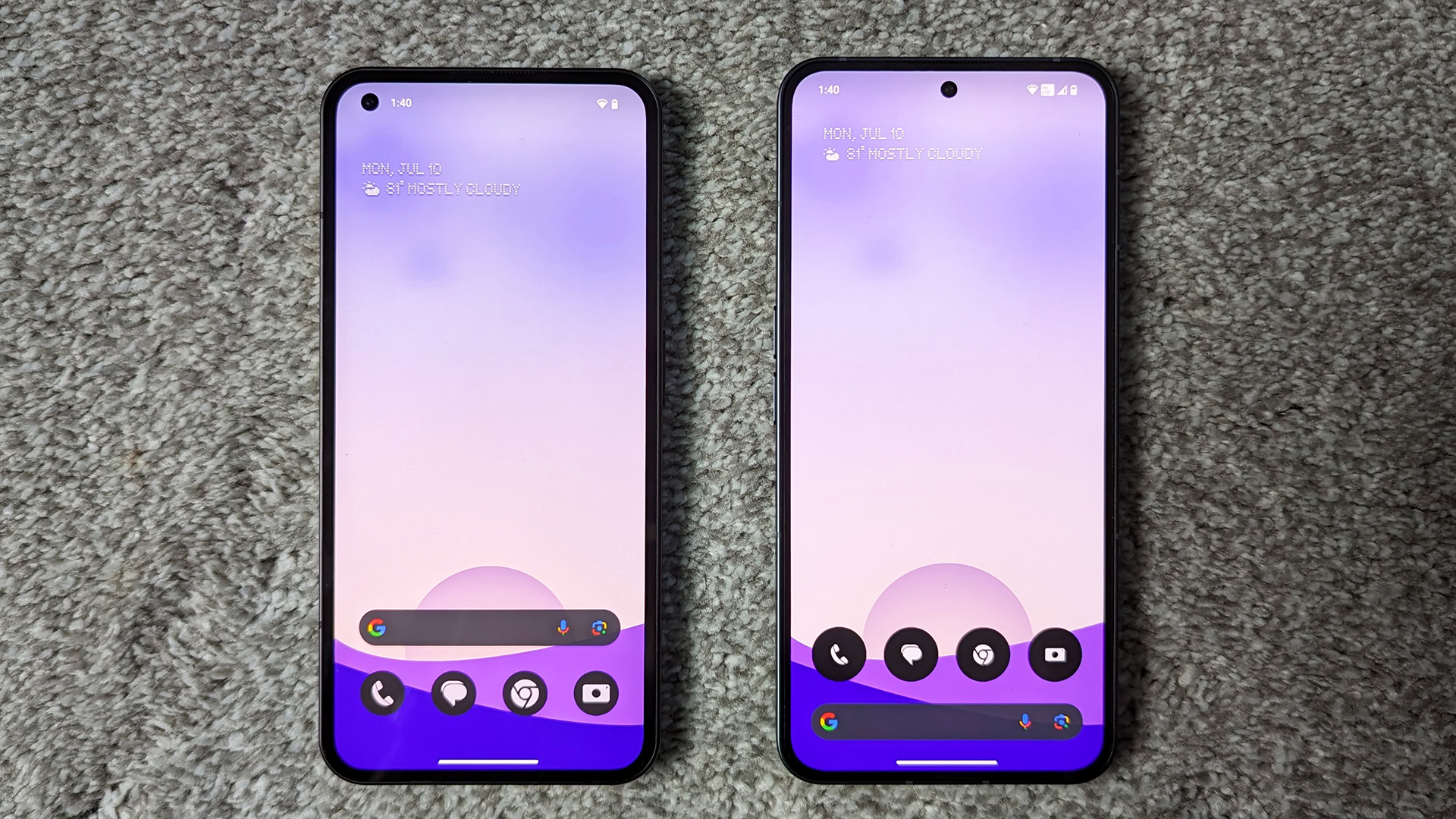
C. Scott Brown / Android Authority
The Nothing Phone 2’s display is not only bigger at 6.7 inches, but it is also marginally better even though it is still FHD+ resolution (2,412 x 1,080). Most of it boils down to the LTPO tech, which is now on offer, allowing the display to vary its refresh rate from 1Hz to 120Hz depending on the content.
There’s also a bump up to 1,600 nits for peak brightness, which should be noticeable in HDR content. Nothing continues to use a flat OLED display on its flagship phone, protecting it with Gorilla Glass 5.
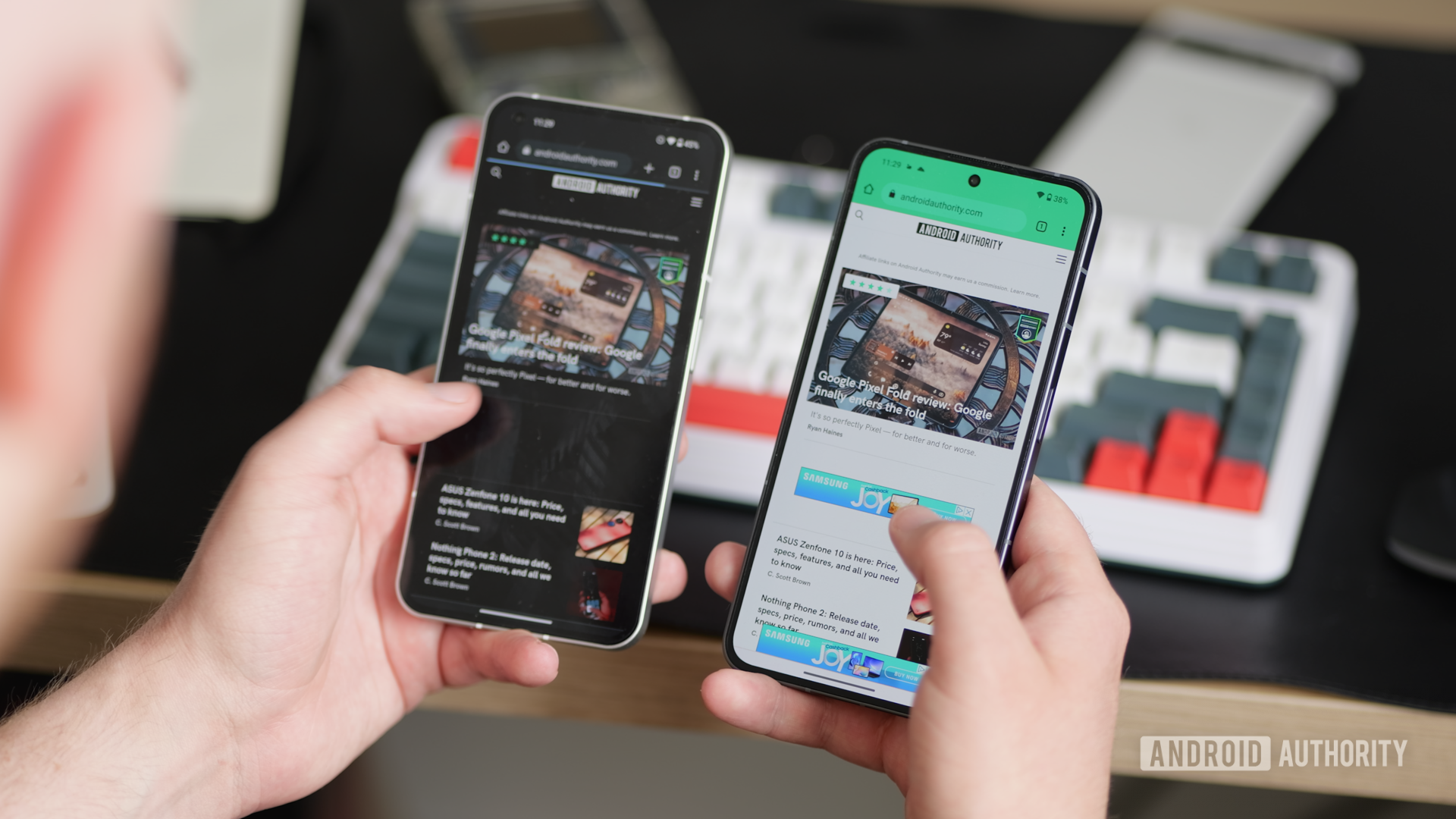
Damien Wilde / Android Authority
The Snapdragon 8 Plus Gen 1 is a great chip that gives the Nothing Phone 2 an edge over the Phone 1.
While the 778G Plus is an excellent upper mid-range chip, the 8 Plus Gen 1 sits firmly in the flagship territory. It’s not the latest or the best chip right now (that would be the Snapdragon 8 Gen 2), but it sits in second position and is an excellent choice for its performance-price ratio. With this, the Phone 2 performs noticeably better than the Phone 1.
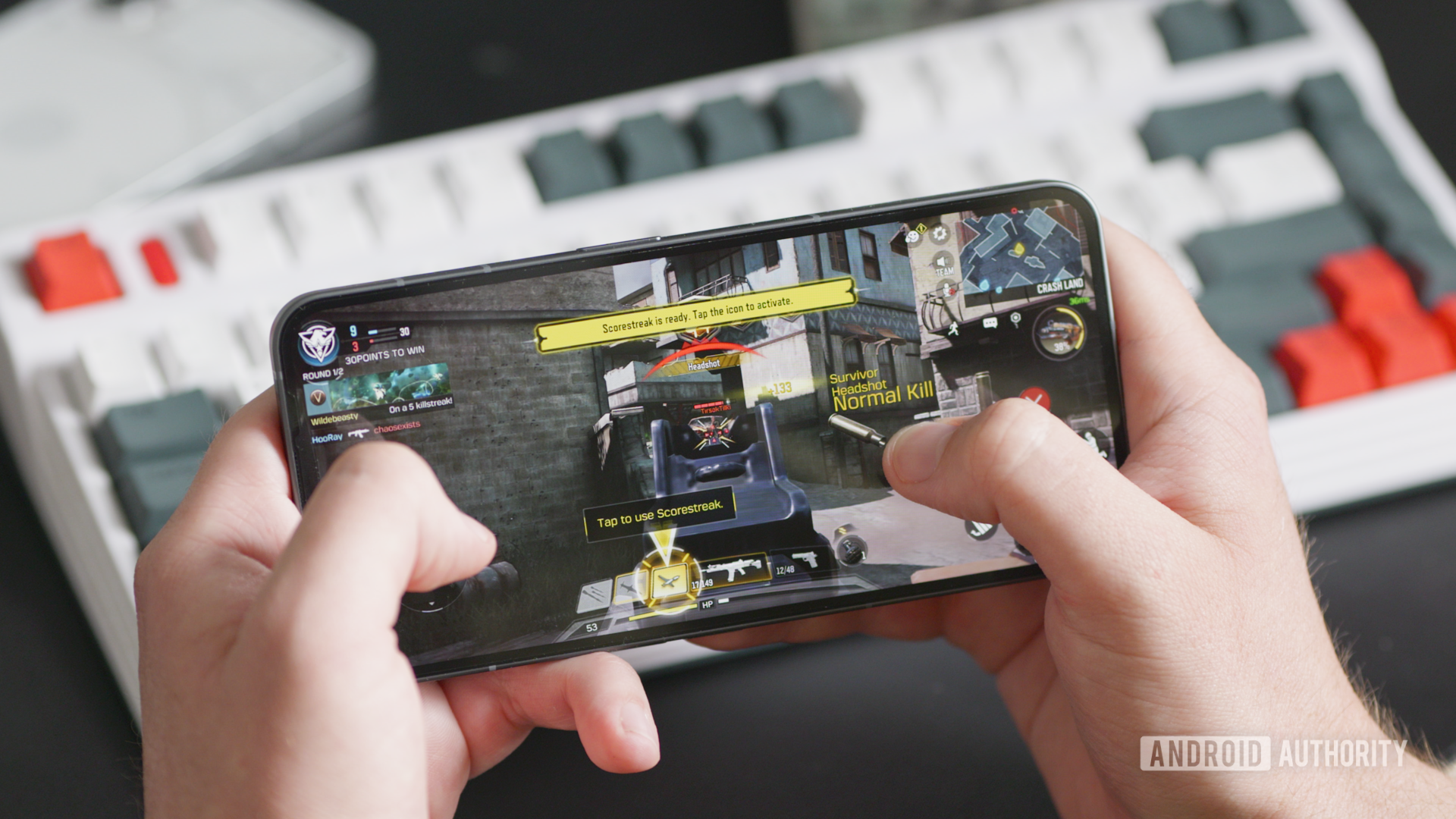
Damien Wilde / Android Authority
For storage and memory, the two phones are largely the same, with an option for higher storage on the Phone 2. You can get 128GB, 256GB, or the new 512GB of UFS 3.1 internal storage coupled with 8GB or 12GB of LPDDR5 RAM. With the bump up to the flagship chip, it would have been nice to get upgrades to UFS 4.0 and LPDDR5X, but this isn’t a dealbreaker either. There’s still no microSD card slot, though.
Other incremental upgrades from the Phone 1 to the Phone 2 include going from IP53 to IP54 for dust and water protection, an upgrade to Bluetooth 5.3, and more 5G bands.
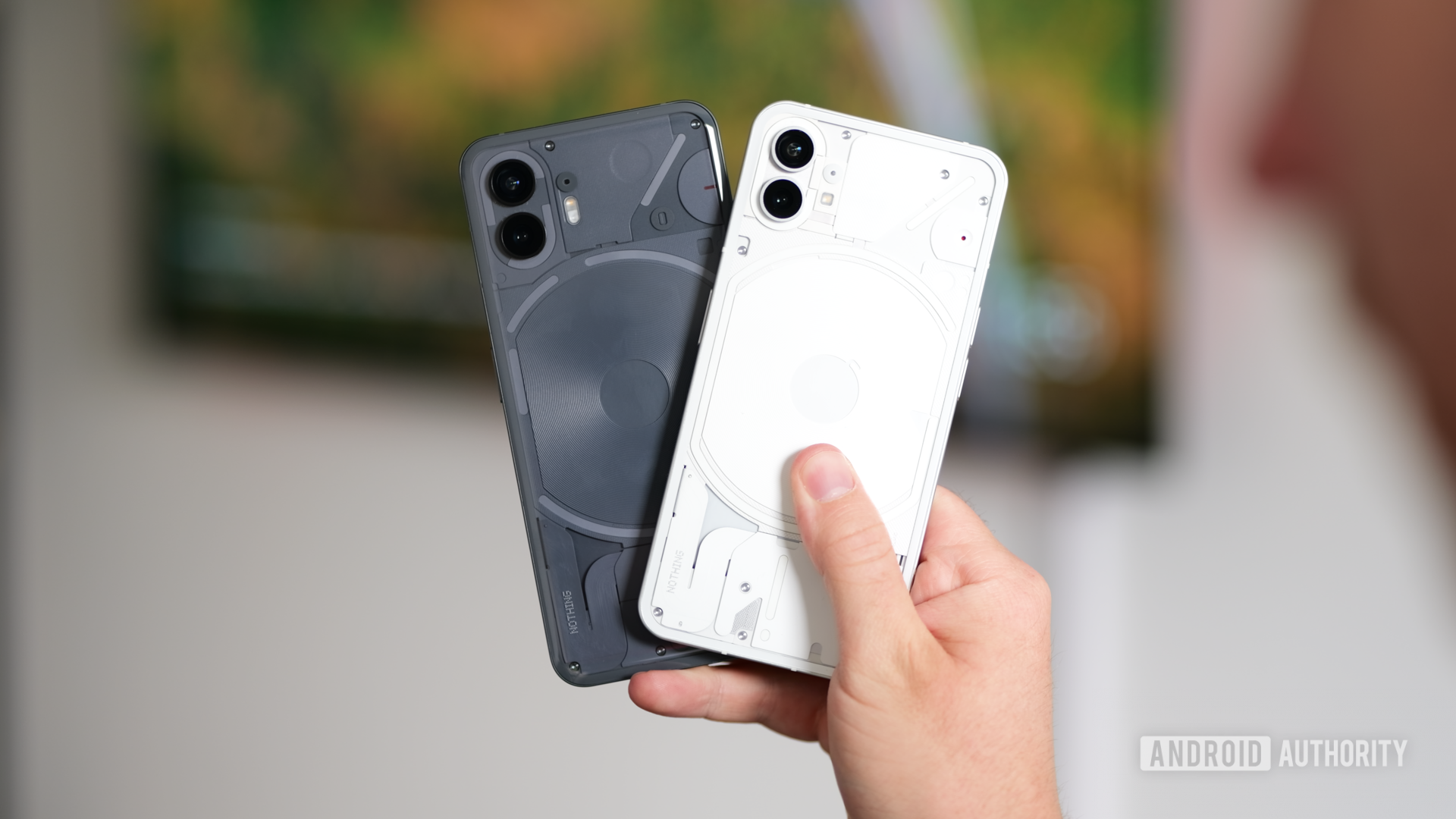
Damien Wilde / Android Authority
Since both the Phone 1 and Phone 2 are from Nothing, the software experience is very similar. Nothing OS takes stock Android and sprinkles a few changes from Nothing without trying to reinvent the wheel. The Phone 2 gets Nothing OS 2.0, which adds some more customization options for the homescreen, lockscreen, and widgets. The Phone 1 will also receive an update to Nothing OS 2.0 in August, so the experience will equalize soon.
Nothing also promises three years of Android updates and four years of security updates (once every two months). Since the Phone 2 is launching a full year later, it will be supported for a year over the Phone 1.
Nothing Phone 1 vs Nothing Phone 2: Size comparison
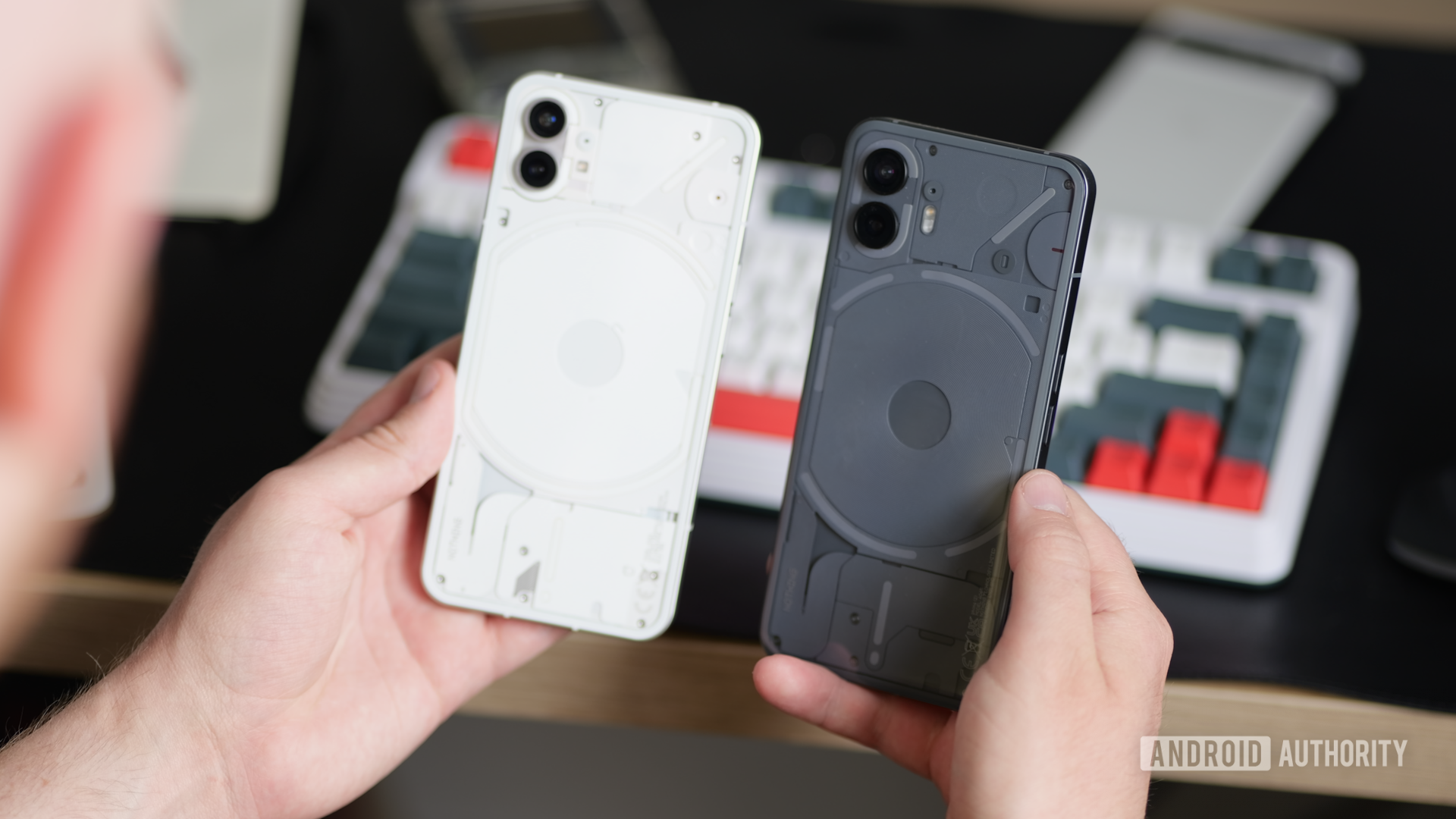
Damien Wilde / Android Authority
There’s a noticeable size difference between the two phones. The older Nothing Phone 1 measures 159.2 x 75.8 x 8.3mm and weighs 194g, while the new Nothing Phone 2 measures 162.1 x 76.4 x 8.6mm and weighs 201g.
The slight chamfer on the back glass of the Phone 2 gives it a more comfortable feel over the Phone 1.
What adds to the feeling of difference is how the back of the Phone 2 is shaped. Nothing has added a slight chamfer between the metal frame and the back glass, which allows the Phone 2 to be held more comfortably than the Phone 1, despite the larger size.
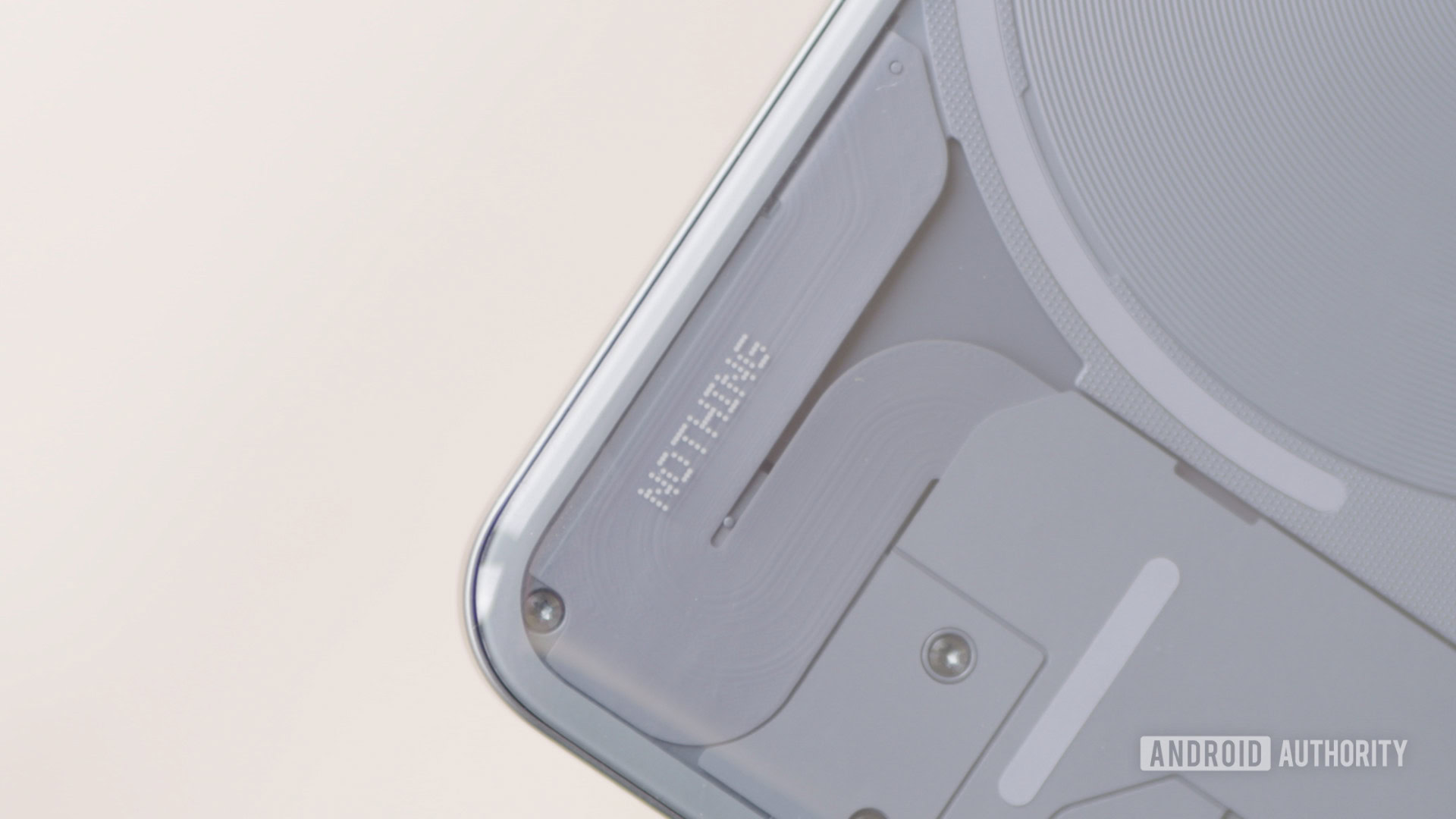
Damien Wilde / Android Authority
Nothing has retained the transparent design language from the Phone 1 to the Phone 2. The back glass remains transparent, giving you a clear view into the internals of the phone. Nothing does cover up most of the bare circuitry with panels, so you cannot directly see components like the motherboard and battery. But you can see the cooling pipes that the phones employ and the wireless charging coil. The look is noticeably unique to Nothing’s phones for now.
The Phone 1 comes in White and Black colors, while the Phone 2 comes in White and Dark Gray.
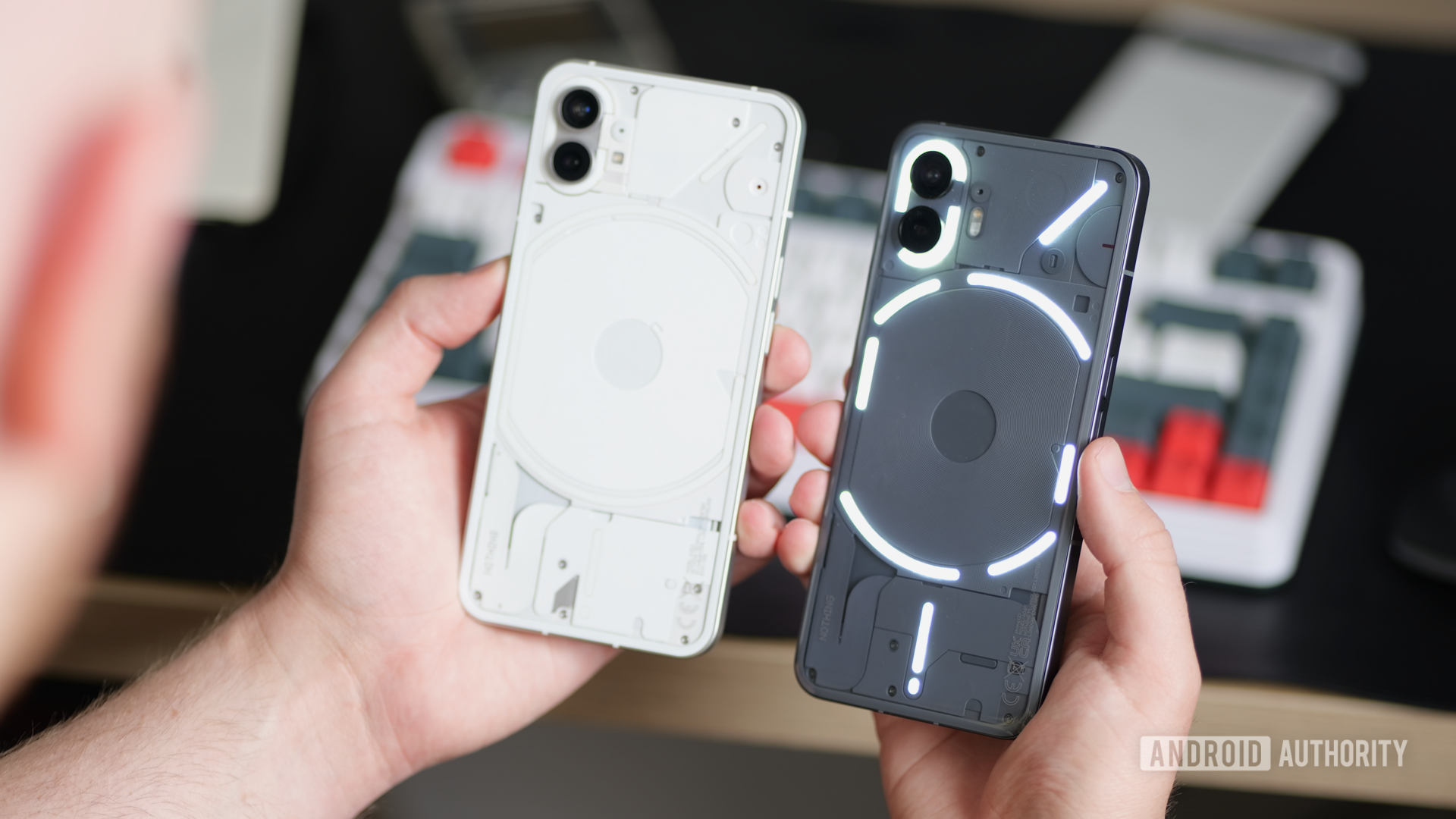
Damien Wilde / Android Authority
One thing that is noticeably different on the Phone 2 from the Phone 1 is the Glyph lighting system on the back of the phone. The Phone 1 started off with 12 individually addressable LED zones spread across five LED strips. The Phone 2 bumps this up to 33 individually addressable LED zones spread across 11 LED strips.
The Phone 2 lets you do more with the LED strips on the back.
This gives users more customization options and granularity, opening up more use cases. For example, with Essential Glyph Notifications, you can set some LEDs to persistently blink when you have notifications from some important apps until you clear the notification.
You can also use the LEDs as a countdown timer, a battery indicator, or even a volume indicator. There’s third-party integration with apps though currently, this is limited to Uber in the US. This will use the Glyph as a countdown timer till your cab arrives.
Nothing Phone 1 vs Nothing Phone 2: Camera
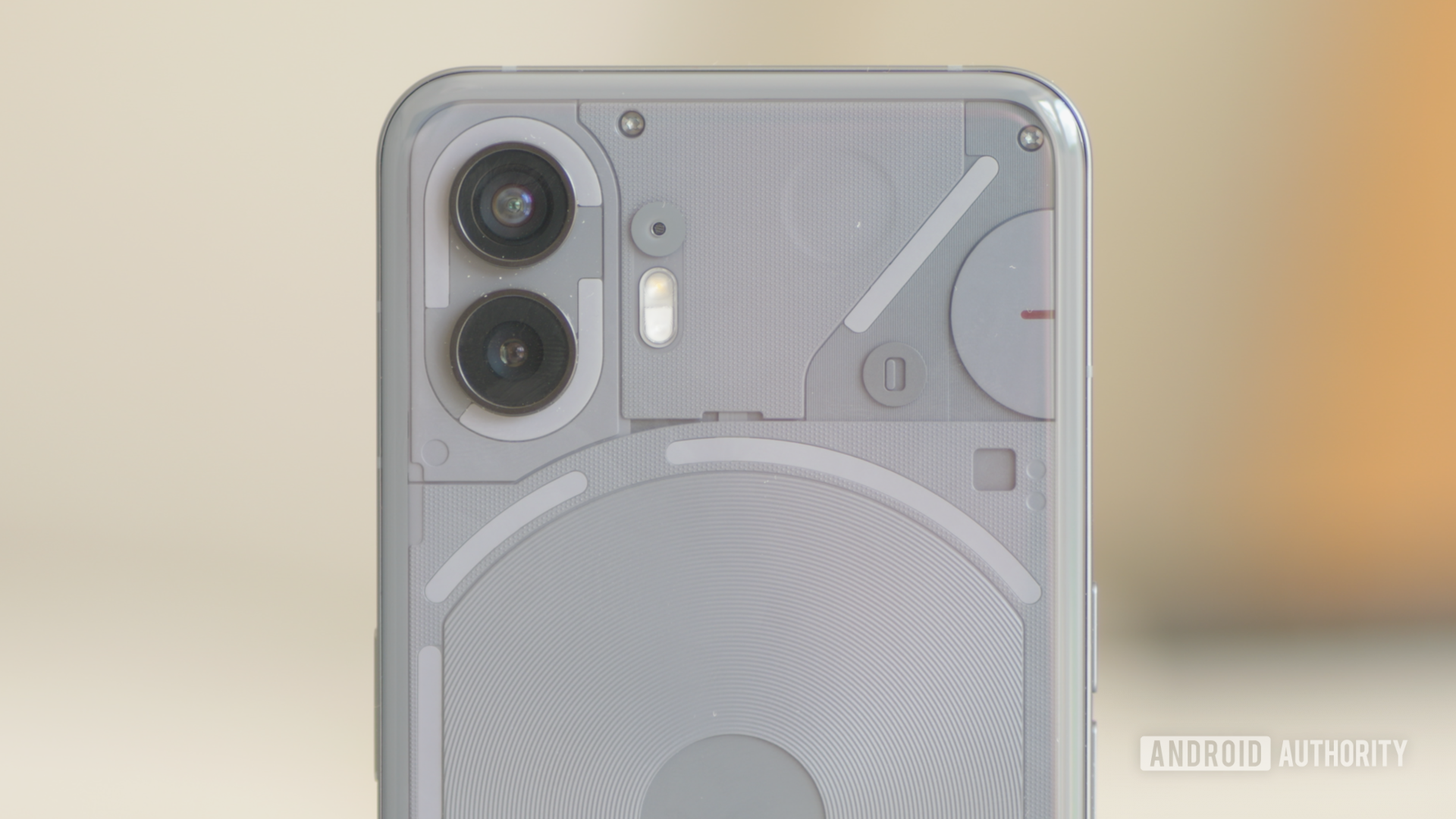
Damien Wilde / Android Authority
This is one area where the Nothing Phone 2 spec sheet may make it look like a significant jump because of the marketing names involved.
For starters, Nothing is not doing anything too experimental with the cameras. Both, Phone 1 and Phone 2, have two rear cameras: a primary and an ultrawide.
The primary camera jumps from the 50MP Sony IMX766 on the Phone 1 to the 50MP Sony IMX890 on the Phone 2. The branding indicates a big improvement, but the sensors are actually very similar, with both having an f/1.88 aperture, 1/1.56-inch sensor size, shooting 1µm pixels, and OIS and EIS support. The only real change this sensor upgrade brings is the ability to shoot 4K at 60fps.
That being said, Nothing has done a great job of improving the primary rear camera’s software processing on the phone. The Nothing Phone 1’s primary rear camera was very forgettable when the phone launched. But later software updates really helped the camera shine bright. With the new Phone 2, we hope the company keeps improving to compete directly against the best camera phones in the market.
Nothing Phone 1 primary camera samples
Nothing Phone 2 primary camera samples
For the rest of the cameras, the rear ultrawide camera on both the Phone 1 and the Phone 2 is the 50MP Samsung JN1 sensor, with f/2.2 aperture, 1/2.76-inch sensor size, and a 114-degree field of view.
Nothing Phone 1 ultrawide camera samples
Nothing Phone 2 ultrawide camera samples
On the front, the 16MP Sony IMX471 on the Phone 1 is being replaced with a 32MP Sony IMX615, capable of shooting 1080p at 60fps.
Nothing Phone 1 front camera samples
Nothing Phone 2 front camera samples
We’ll be adding more Nothing Phone 2 camera samples once the embargo allows us to.
Overall, there isn’t all that much that has changed on the camera end of the spec sheet. The Nothing Phone 2 has some nice improvements, but we wouldn’t consider the cameras to be the biggest upgrades on the phone compared to the Phone 1.
Nothing Phone 1 vs Nothing Phone 2: Battery and charging
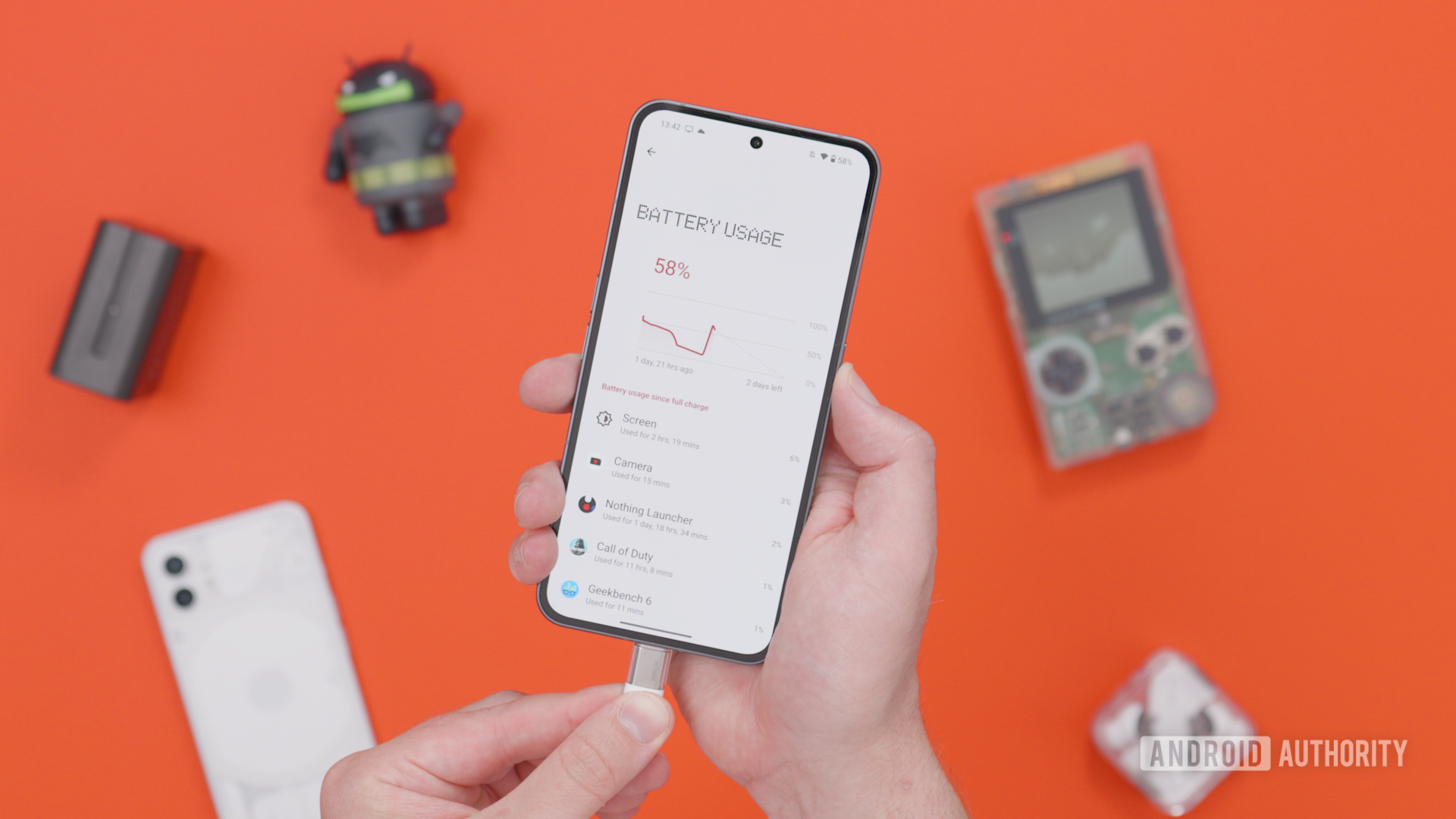
Damien Wilde / Android Authority
The Nothing Phone 1 has a 4,500mAh battery that can give most users about six hours of screen-on time and a comfortable day of use. If you have a heavier day, you can expect the phone to last till the end. The battery isn’t the highlight of the phone, but it works well enough not to give you any unnecessary anxiety.
The Nothing Phone 2 goes up to 4,700mAh for its battery. The Snapdragon 8 Plus Gen 1 is a surprisingly power-efficient chip, so you can expect similar battery life despite the performance gains.
Charging has improved from 33W USB Power Delivery PPS on the Phone 1 to 45W USB PD PPS on the Phone 2. The Phone 1 took 71 minutes for a full charge. Even with a larger battery, the Phone 2 should be able to match the Phone 1 thanks to the quicker charging. Nothing claims that a full charge should take 55 minutes, which is a good upgrade.
Both phones also support 15W wireless charging and 5W reverse wireless charging. Neither phone comes with a charger in the box, though.
Nothing Phone 1 vs Nothing Phone 2: Price
- Nothing Phone 1 (8GB + 128GB): £399 (~$472)
- Nothing Phone 1 (8GB + 256GB): £449 (~$532)
- Nothing Phone 1 (12GB + 256GB): £499 (~$591)
- Nothing Phone 2 (8GB + 128GB): $599
- Nothing Phone 2 (12GB + 256GB): $699
- Nothing Phone 2 (12GB + 512GB): $799
The Nothing Phone 1 was not launched in the US, so a direct price comparison is a bit complicated. We’re converting the UK prices to USD at the rates applicable at the Phone 1’s launch. At those prices, the Nothing Phone 1 was considered a sub-$500 smartphone, though with the big caveat that you could not directly purchase it in the US.
At launch, the Nothing Phone 2 clearly breaches the $500 mark. It’s priced very well, starting at $599, but it still makes the Nothing Phone 1 look like a value offering, especially if you are on a tighter budget. Pre-orders for the Nothing Phone 2 are live from July 11, 2023. The Phone 2 goes on sale on July 17, 2023.
Nothing Phone 1 vs Nothing Phone 2: Should you upgrade?
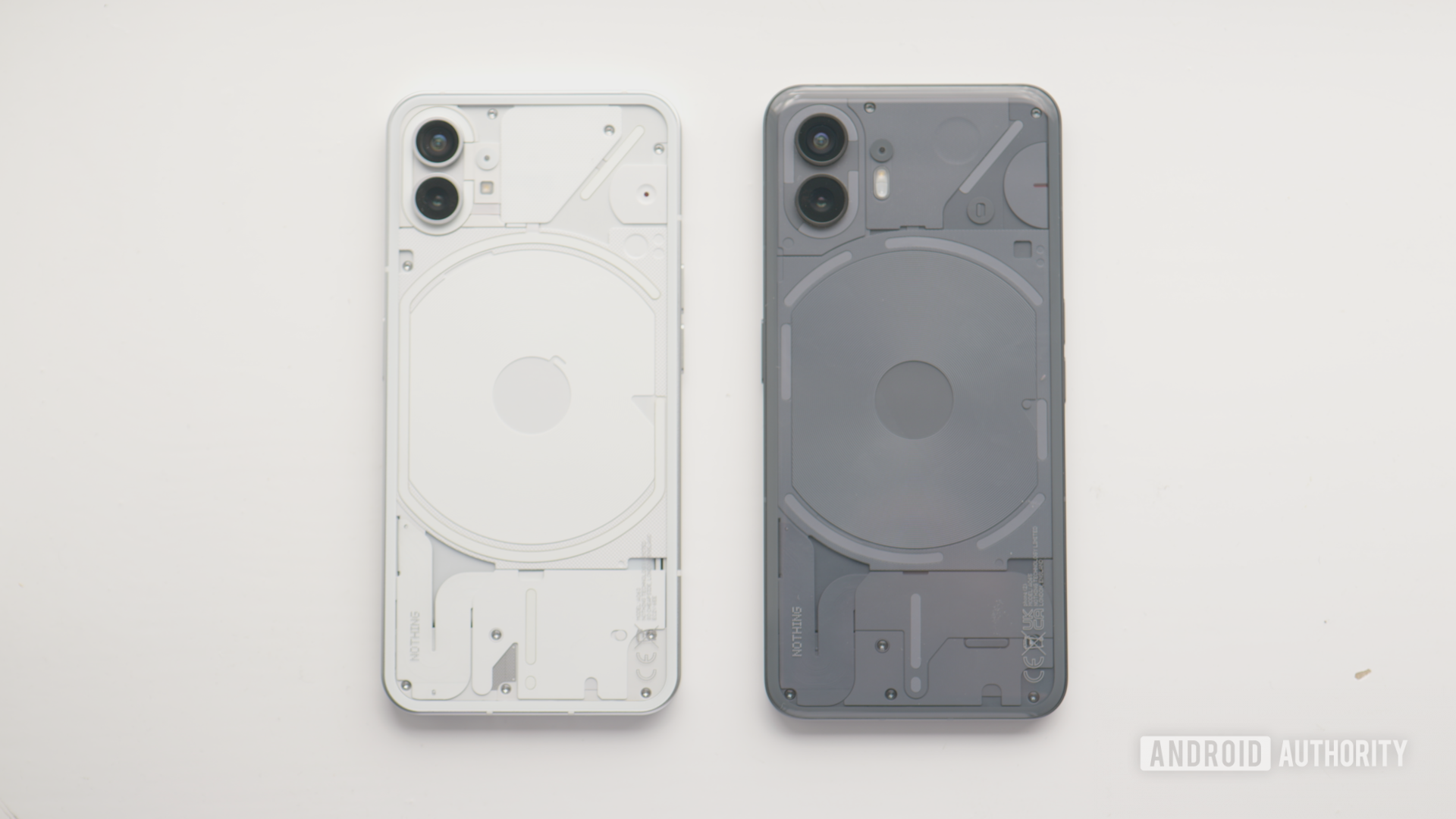
Damien Wilde / Android Authority
The Nothing Phone 2 is a meaningful upgrade over the Phone 1, and the Snapdragon 8 Plus Gen 1 is a gem of a chip that is worthy of praise. But with that being said, the upgrade comes at a cost, which may not be easy to justify for everyone.
What would you prefer buying right now, the Nothing Phone 1 or the Nothing Phone 2
0 votes
As a standalone recommendation, both the Nothing Phone 1 and the Nothing Phone 2 are great phones. If your Phone 1 continues to function well, you don’t need to upgrade to the Phone 2. While you will see good improvements in performance and battery life, you’d have to shell out good money for a new phone. We’d recommend using the Phone 1 for another year or two, as long as it serves you well.
If you’re in the market for a new phone and want to pick up between the Phone 1 and the Phone 2, the Phone 2 is the obvious choice. For one, it is officially sold in the US, guaranteeing better support than what you would have gotten on an imported Phone 1. Two, the Snapdragon 8 Plus Gen 1 is enough of an upgrade that it makes sense to jump up to the more expensive phone.
The Snapdragon 8 Plus Gen 1 is enough of an upgrade to prefer the Nothing Phone 2 over its predecessor.
There is a lot that the Nothing Phone 2 does better than the Phone 1, and as a newer phone and the successor to the line, it makes sense to go for it.
The only situations where the Phone 1 makes more sense than the Phone 2 is if you’re getting a steal deal on it or you have a tight budget that you cannot exceed by a hair. The spec upgrade on the Phone 2 is worth the premium charged, though, and unless you have a strict budget, the Phone 2 is our recommendation.


